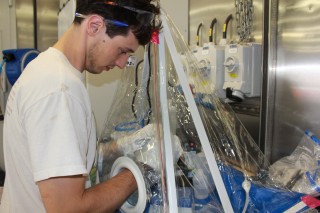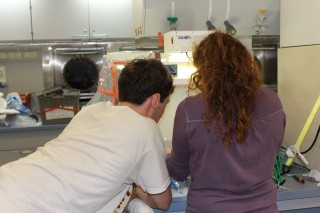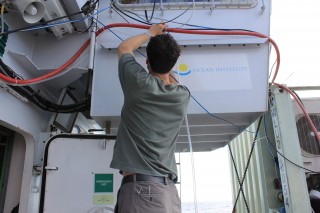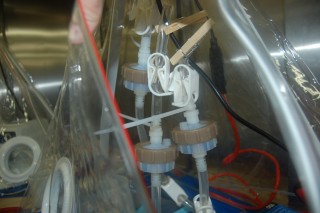What does it take to measure iron in the ocean? The science crew of the R/V Falkor are intimately familiar with this question.

The concentrations of iron at Loihi seamount are quite high for ocean water, but in actuality, they are extremely low –equating to a drop of water in an Olympic-sized swimming pool! However, when this flux of iron is translated to a geologic time scale, this amount turns significant for the ocean and the life it supports around Loihi.
In order to be able to measure such small concentrations, the science crew must go to great lengths to ensure that the measurements will be accurate and precise. At the concentrations present in the samples, contact with any metal objects can spoil the sample’s purity. One way we minimize metal contact is by using teflon bottles because they have a special chemical property that makes its surface slippery towards metals.
Cleanliness is the rule

Our sampling all starts with a dish washing regimen that would make most germaphobes ecstatic. Bottles are first rinsed with ultra pure water, and then filled with a dilute special detergent. The labware is placed in an oven for a week (yes, that’s right, a whole week), baked at really high temperatures, and then rinsed out with more ultra-pure water. The bottles are then filled with water that has been mixed with special acids nearly free of metals. The bottles go back into the oven overnight, sit out for a week, and then are placed in Ziploc bags. This process called “leaching”, mobilizes any metallic compounds that are stuck to the sides of the bottle so they can be dumped out. All laboratory implements also go through this leaching process to ensure that no contamination is introduced. We aim for even higher “cleanliness” than doctors would for their surgeries.

Once we have our clean equipment, we collect and process our desired iron samples. This can be tricky on a ship that is composed of metal, especially after the effort we put into eliminating outside metals. Using special laboratory devices called “laminar flow hoods” we can isolate our samples from the ship so they do not get contaminated. These “hoods” are essentially boxes with fans built into them, and provide scientists with a clean room that is just big enough for their hands. This means that any metal-bearing particulates in the ship’s environment are kept away from sensitive samples. Only plastic or ceramic tools are used, and scientists wear special gloves that have been manufactured in low particle environments. Talk about a lot of work just to avoid some metals!
Preserving samples

Once the samples are taken from the ocean using the bottles on the CTD Rosette, they are preserved in special ways depending on the type of information that the science crew hopes to gain from them. Some samples are frozen or refrigerated, others are acidified with ultra clean hydrochloric acid to keep the iron dissolved and off of the walls of the sample containers. Samples of particulate iron are filtered, bottled, and bagged in the oxygen and carbon dioxide-free atmosphere of a glove bag. These bags are filled with nitrogen, a gas that is non-reactive towards the iron compounds in the water samples. This allows for speciation measurements to be made, which provide the science crew with valuable information about the nature of the hydrothermal plume at Loihi.
Finally, the samples reach the end of their short, clean lives at the plasma torches, x-ray beams and electrodes of various analytical instrumentation on land or at sea. Some samples are analyzed on board the ship using spectrophotometers (instruments that use light to measure the concentration of iron), and others are sent back to land to be analyzed using sensitive instruments that use high temperatures and magnets to quantify metals.
This process shows how much detail scientists have to consider, however, it is the painstaking details that give a big payoff in the end. The information that comes from the samples collected on this trip, help to inform our understanding of the incredible ecosystems of the hydrothermal vents, and the roles they play in ocean chemistry and composition at large.

